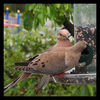Help with V600 scanner
Mar 2, 2019 20:27:19 #
I am guilty of buying equipment for projects that will someday start. I have a V600 Epson scanner and noticed by the posts that it is very popular. I've used it right out of the box about a 18 months ago, scanned about 30 slides and have not touched it since.
I have a lot of slides to scan, when my kids were kids I shot mostly Ektachrome and Kodachrome.
This first experience with the scanner was slow and I wonder if I was doing the process incorrectly.
I've developed an allergy to reading manuals and was hoping someone would donate a few minutes to summarize the process. All I want to do is scan 35mm slides, from the V600 to my iMac.
I surely would appreciate it.
Claude
I have a lot of slides to scan, when my kids were kids I shot mostly Ektachrome and Kodachrome.
This first experience with the scanner was slow and I wonder if I was doing the process incorrectly.
I've developed an allergy to reading manuals and was hoping someone would donate a few minutes to summarize the process. All I want to do is scan 35mm slides, from the V600 to my iMac.
I surely would appreciate it.
Claude
Mar 2, 2019 21:22:55 #
You say that the scanning you did was very slow. What DPI were you scanning at? The higher the DPI the slower the scan. I scanned hundreds of slides with my V600 in a reasonable length of time. As I recall I used 300 DPI.
Mar 2, 2019 22:23:34 #
Probably at highest resolution, if set at 300 dpi, normally how long should it take?
Mar 2, 2019 22:34:05 #
sanhuberto wrote:
Probably at highest resolution, if set at 300 dpi, normally how long should it take?
I don't remember. It's been over a year since I scanned any slides. If you are scanning at maximum DPI then it will definitely take way too long for normal usage. I suggest you scan a set at various DPI and see what results best suits your needs. 300 DPI would be a good place to start.
Mar 2, 2019 23:11:00 #
I bought a Canon 9000F II scanner, the highest resolution one at the time. After experimenting I came to the conclusion that 300 dpi is fine for doing high resolution prints. You can go really high but it eats up space on your hard drive and takes forever to scan and process without any noticeable improvement in the print.
Mar 2, 2019 23:38:49 #
Turn off the ICE feature on your scanner, and the scanning time will be greatly reduced!
I quit using the ICE feature after the first week or so, as it only removed some dust spots, leaving me to manually edit out the rest afterwards. And also because the ICE feature also softened the images somewhat.
I quit using the ICE feature after the first week or so, as it only removed some dust spots, leaving me to manually edit out the rest afterwards. And also because the ICE feature also softened the images somewhat.
Mar 3, 2019 06:03:04 #
sanhuberto wrote:
Probably at highest resolution, if set at 300 dpi, normally how long should it take?
My default setting is 300 dpi, and it moves along quickly. I haven't done slides in ages, but I seem to recall using 300 for them, as well. Experiment to see what works best for you. Higher resolution will take longer, but the results will be better. You have to find the sweet spot that balances scanning time with image quality.
Digitizing resolution -
http://howtoscan.ca/scanning-tips/best-slide-scan-resolution.php
http://www.rideau-info.com/photos/scanning.html
https://www.pcworld.com/article/2011344/preserve-all-your-precious-images-the-right-way.html
https://www.scanyourentirelife.com/qa-whats-best-dpi-or-resolution-scan-your-film-negatives/
http://www.digitalmemoriesonline.net/scan/scan_processing/resolving_scanning_resolution.htm
Mar 3, 2019 08:47:08 #
DPI does indeed effect the scan time, but even at 300 DPI, it's going to be a time consuming process overall. My scanner will do 4 slides at a time and a 300 DPI scan still takes a couple minutes. Sorting through old slides and only scanning the ones you really want to keep can help the overall workload, but this conversion is going to take a commitment in time. Try to blow off dust and properly align the slides as you scan them or you'll be doing some of them over to "get it right." The Epson V600 does a nice job, but it's not a speedy process, good luck and good shooting to all.
Mar 3, 2019 08:51:27 #
I prefer to scan slides at a higher resolution, as most of them will be enlarged when printed.
You'll need to do the math: decide what resolution you want for your prints, then calculate what resolution you need to scan at.
As to the scanner being slow: yes it is and get slower when you increase resolution.
To avoid the "watching paint dry-feeling", I set up the scanner, load the slides or negatives into the holders, hit the "Scan" button and walk away to do something else: have a coffee (or whatever you favourite beverage is), read a book, watch the news on tv (enough scandals to keep you occupied for a while). When you come back your scan is done and you can set up the next one.
You'll need to do the math: decide what resolution you want for your prints, then calculate what resolution you need to scan at.
As to the scanner being slow: yes it is and get slower when you increase resolution.
To avoid the "watching paint dry-feeling", I set up the scanner, load the slides or negatives into the holders, hit the "Scan" button and walk away to do something else: have a coffee (or whatever you favourite beverage is), read a book, watch the news on tv (enough scandals to keep you occupied for a while). When you come back your scan is done and you can set up the next one.
Mar 3, 2019 10:15:31 #
DIRTY HARRY
Loc: Hartland, Michigan
I'm really confused now. If 300 dpi (which my Epson 1200 U could easily accommodate and I have scanned all of my slides and 35 mm & 6X6 negatives at it's highest resolution) is adequate for 35 mm slides, why did I just spend over $200 for a V600 for "better" scans?
Mar 3, 2019 12:03:03 #
If you ever intend to make prints of any reasonable size from your scanned slide, you need to set the V600 or any scanner to an order of magnitude greater than the 300 dpi setting discussed so for here.
If scanning 35mm (also known as 135) slides or negatives, the optimum scanning resolution appears to be 3200 (this may vary from 3000 to 3600 depending on software). You can scan at a higher DPI if desired, but you will likely find that you are not capturing more detail, just making more pixels.
The above is from a quick Google search.
Assuming you want to send your printer a file that is 300 ppi, the recommended DPI setting will produce enough pixels to print a high quality 8x10 without interpolating pixels.
But maybe I am missing something here. And yes it is going to be time consuming.
FWIW
If scanning 35mm (also known as 135) slides or negatives, the optimum scanning resolution appears to be 3200 (this may vary from 3000 to 3600 depending on software). You can scan at a higher DPI if desired, but you will likely find that you are not capturing more detail, just making more pixels.
The above is from a quick Google search.
Assuming you want to send your printer a file that is 300 ppi, the recommended DPI setting will produce enough pixels to print a high quality 8x10 without interpolating pixels.
But maybe I am missing something here. And yes it is going to be time consuming.
FWIW
Mar 3, 2019 12:17:06 #
DIRTY HARRY
Loc: Hartland, Michigan
don26812 wrote:
If you ever intend to make prints of any reasonabl... (show quote)
what about 6x6 & 6x7 NEGATIVES?
Mar 3, 2019 13:37:31 #
The same math applies, but because the 6x6 negative/slide is larger, you can use a lower scanning resolution. Assuming that you want to send your printer a file that has a resolution of 300 pixels/inch (the normal recommended resolution, you could print a 20"x20" image if you scan the slide at 1000 DPI.
Here is the math:
6 in x 1000 pix/in x in/300 pix = 20 inches the size of the final print on each side.
Here is the math:
6 in x 1000 pix/in x in/300 pix = 20 inches the size of the final print on each side.
Mar 3, 2019 13:40:33 #
DIRTY HARRY
Loc: Hartland, Michigan
don26812 wrote:
The same math applies, but because the 6x6 negative/slide is larger, you can use a lower scanning resolution. Assuming that you want to send your printer a file that has a resolution of 300 pixels/inch (the normal recommended resolution, you could print a 20"x20" image if you scan the slide at 1000 DPI.
Here is the math:
6 in x 1000 pix/in x in/300 pix = 20 inches the size of the final print on each side.
Here is the math:
6 in x 1000 pix/in x in/300 pix = 20 inches the size of the final print on each side.
Thanks...
Mar 3, 2019 15:20:26 #
On my V600 at 300 dpi (no adjustments, Professional Mode) from the time I click "scan" to the time the image appears on my desktop is 26 seconds (by stopwatch). Changing slides (no alignment necessary since the frame does that for you) is another 15 seconds. That's over 300 slides an hour if you hustle. However, 300 dpi is the very minimum resolution recommended for scanning large items. For 35mm slides, I'd go much higher, at least 1200 dpi, especially if you're making large prints or showing them on a monitor. At 1200 dpi, the scan time was 2:15 or almost 100 slides per hour.
If you want to reply, then register here. Registration is free and your account is created instantly, so you can post right away.




